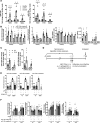MicroRNA-125a and -b inhibit A20 and MAVS to promote inflammation and impair antiviral response in COPD
- PMID: 28405612
- PMCID: PMC5374076
- DOI: 10.1172/jci.insight.90443
MicroRNA-125a and -b inhibit A20 and MAVS to promote inflammation and impair antiviral response in COPD
Abstract
Influenza A virus (IAV) infections lead to severe inflammation in the airways. Patients with chronic obstructive pulmonary disease (COPD) characteristically have exaggerated airway inflammation and are more susceptible to infections with severe symptoms and increased mortality. The mechanisms that control inflammation during IAV infection and the mechanisms of immune dysregulation in COPD are unclear. We found that IAV infections lead to increased inflammatory and antiviral responses in primary bronchial epithelial cells (pBECs) from healthy nonsmoking and smoking subjects. In pBECs from COPD patients, infections resulted in exaggerated inflammatory but deficient antiviral responses. A20 is an important negative regulator of NF-κB-mediated inflammatory but not antiviral responses, and A20 expression was reduced in COPD. IAV infection increased the expression of miR-125a or -b, which directly reduced the expression of A20 and mitochondrial antiviral signaling (MAVS), and caused exaggerated inflammation and impaired antiviral responses. These events were replicated in vivo in a mouse model of experimental COPD. Thus, miR-125a or -b and A20 may be targeted therapeutically to inhibit excessive inflammatory responses and enhance antiviral immunity in IAV infections and in COPD.
Conflict of interest statement
Conflict of interest: The authors have declared that no conflict of interest exists.
Figures







References
Publication types
MeSH terms
Substances
LinkOut - more resources
Full Text Sources
Other Literature Sources
Medical
Miscellaneous

